Inhabitants of Oregon's Tidepools: Other visitors
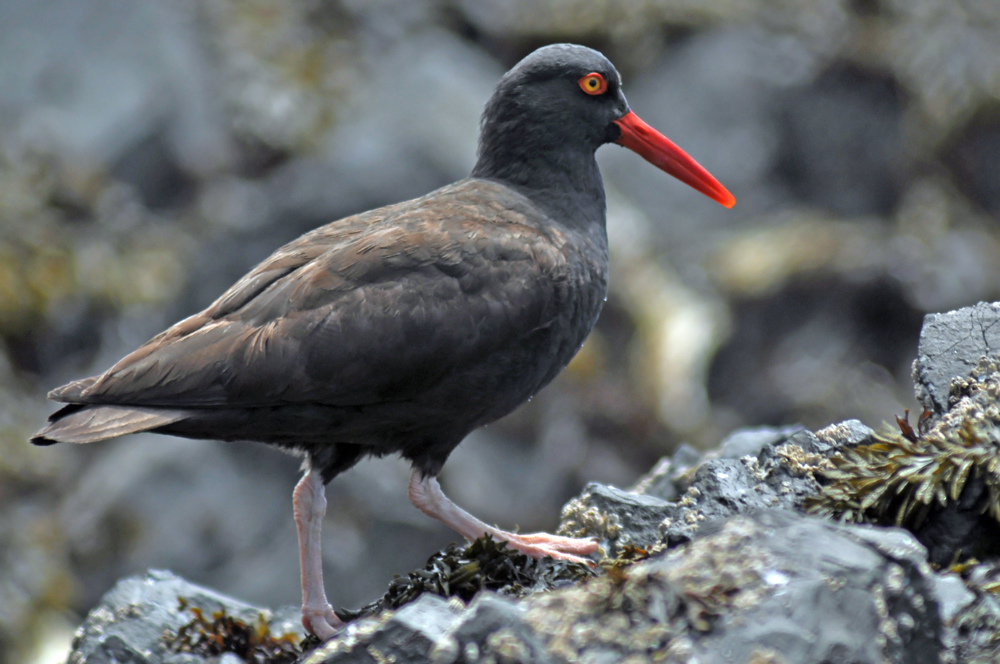
Just as people are drawn to the edge of the sea, other animals are drawn here, too.
Look down the shore a bit, away from people, and you’ll probably see other land- and air-based animals on the exposed ocean bottom.
Many shorebirds are adapted to feeding at the water’s edge or just beneath water or substrate. The more-familiar shorebirds, such as various sandpipers, probe beach sediments for their prey, but there are also shorebirds that make a living on the rocky shore.
Do not disturb the other visitors to the rocky intertidal; this is important feeding and resting habitat for them.
Black oystercatchers feed by probing among rocks and in the mussel beds for crabs and other prey, by prying limpets off the rocks, by deftly inserting their bill into a mussel to cut it open or by hammering shells open. Each oystercatcher may favor a particular feeding technique and mates with another that feed the same way; together the adults teach their offspring the family feeding methods.
Robin-sized, surfbirds and turnstones walk over the exposed intertidal communities, poking through the seaweeds and attached animals with short, pointed bills, seeking small prey. Look for their distinctive black-and-white wing markings.
Ever opportunists, gulls wander the rocky intertidal seeking loose prey and other edible bits. And, not limited to sandy shores, herons come to the edges of all waters to catch fish, invertebrates, and other animals.
The wildlife using offshore rocks, reefs and islands are extremely susceptible to human disturbance, thus they are closed to public entry year-round by the US Fish and Wildlife Service (USFWS). Visit the coastal wildlife viewing page of Oregon's coastal branch of the USFWS for more information.

Evolved from land animals millennia ago, now-seagoing seals and sea lions rest on the sea’s edge. (With somewhat different body structures, sea lions can walk on land, seals can only worm and wiggle on land.) Harbor seal are common on Oregon’s rocky shore, as are California sea lions and Steller sea lions.
Baby seals may rest on shore when the mother is off fishing; please do not disturb them—the mother will come back and care for them.
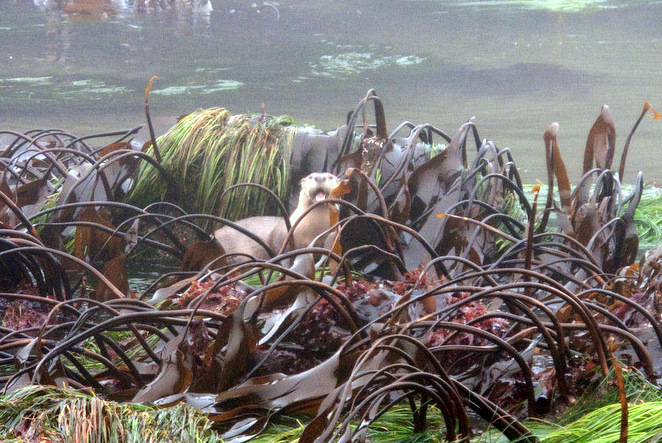
Fellow mammals such as raccoons and river otters visit tidepools seeking a meal. While rare, sea otters occasionally visit coastal Oregon. Visit this USFWS page to learn how to tell the difference between river and sea otters.
Inhabitants of Oregon's Tidepools: Sculpins
Both appearance and behavior benefit this fish.
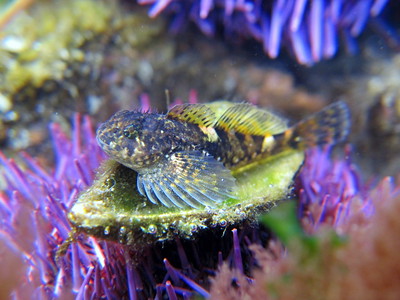 Usually, it’s the behavior that catches people’s eyes. The mottled patterns that cover the entire body of sculpins help it blend extremely well with the tidepool bottom.These common fish are shaped like long, drawn-out teardrops, but with broad pectoral fins located just past the head. Rather triangular in cross section and with a long fin that runs down the back, tidepool sculpins rest on the bottom with their pectoral fins spread out on either side. The entire body is variously marked in browns, olive greens, and whites—often in saddles across the back. All of the several different species of tidepool sculpins are small, up to several inches long.
Usually, it’s the behavior that catches people’s eyes. The mottled patterns that cover the entire body of sculpins help it blend extremely well with the tidepool bottom.These common fish are shaped like long, drawn-out teardrops, but with broad pectoral fins located just past the head. Rather triangular in cross section and with a long fin that runs down the back, tidepool sculpins rest on the bottom with their pectoral fins spread out on either side. The entire body is variously marked in browns, olive greens, and whites—often in saddles across the back. All of the several different species of tidepool sculpins are small, up to several inches long.
The fish will rest/hide quietly, but, when disturbed, will dash off to a new location where it freezes suddenly to blend into the new background, seeming to disappear.
Can you find tidepool sculpins of more than one pattern?
The Oregon Coast is home to several species of sculpins that spend their entire lives in the tidepool zones; some larger sculpin species may live in tidepools when young.
These common fish are shaped like long, drawn-out teardrops, but with broad pectoral fins located just past the head. Rather triangular in cross section and with a long fin that runs down the back, tidepool sculpins rest on the bottom with their pectoral fins spread out on either side. The entire body is variously marked in browns, olive greens, and whites—often in saddles across the back. All of the several different species of tidepool sculpins are small, up to several inches long.
Rarely, tidepool sculpins may misjudge and get caught and eaten by larger sea anemones. More often, they fall prey to larger fish (at high tide) and shorebirds (at low tide).
Inhabitants of Oregon's Tidepools: Sea Palm
Sea palm’s rubbery stalks allow it to bounce right back.
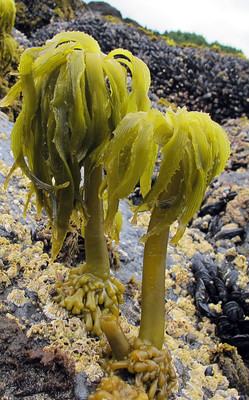 Watch as a wave crashes over them and you’ll see them bounce back up as the water sheds off. Seaweeds have several substances that make them flexible and rubbery—both helpful in avoiding damage by fast-moving water. Two of those, agar and carrageenan, are widely used to make human foods smooth or gelatinous. From toothpaste to soft-serve ice-cream, you’ve certainly eaten seaweed products!True to their name, sea palms look like one- to two-foot tall palm trees, with a smooth “trunk” topped by a thick tuft of ridged “leaves,” each several to ten inches long, that loosely droop down, reaching a quarter to half the way to the rock. The upright stalk is held in place by a mass of curved and branching finger-like projections that hold fast to rock or mussels. The entire seaweed is olive brown.
Watch as a wave crashes over them and you’ll see them bounce back up as the water sheds off. Seaweeds have several substances that make them flexible and rubbery—both helpful in avoiding damage by fast-moving water. Two of those, agar and carrageenan, are widely used to make human foods smooth or gelatinous. From toothpaste to soft-serve ice-cream, you’ve certainly eaten seaweed products!True to their name, sea palms look like one- to two-foot tall palm trees, with a smooth “trunk” topped by a thick tuft of ridged “leaves,” each several to ten inches long, that loosely droop down, reaching a quarter to half the way to the rock. The upright stalk is held in place by a mass of curved and branching finger-like projections that hold fast to rock or mussels. The entire seaweed is olive brown.
Seaweeds don’t have a circulatory system like land plants; the curved and branching finger-like projections that hold it fast to rock or mussels do only that, hold fast.
While sea palms are built to stand up to the forces associated with the ocean, they are sensitive enough to deserve special protections. No collection of sea palms is allowed from anywhere on Oregon's Ocean Shore State Recreation Area.
Notice where sea palms are growing.
Their tough resilience allows sea palms to thrive where waves crash and currents surge the wildest. They can take the waves, but people cannot: If you find yourself near sea palms, you should move to a safer location.
Inhabitants of Oregon's Tidepools: Sea Lettuce
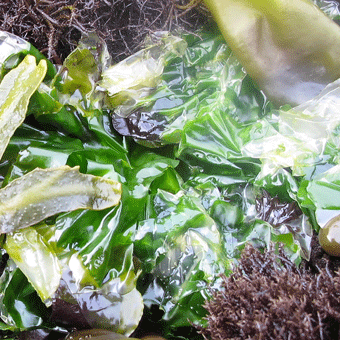
Nearly see-through, sea lettuce can seem to be extremely delicate.
Sea lettuce thrives on the upper beach, an area frequently exposed to air and hot sun. Their thin blades can get quite warm and a bit dry and stiff at low tide, especially in the summer. But sea lettuces are amazingly resilient: they’ll usually rehydrate and recover when the tide returns.
And what if it rains at low tide? Or if it freezes? Sea lettuce is also remarkably tolerant of exposure to fresh water and to cold.
Keep an eye out!
Good thing sea lettuce is fast growing: many animals eat it. Look for tiny black periwinkles grazing the surface of the delicate blades.

